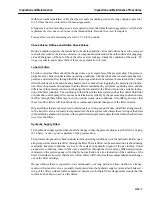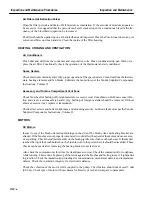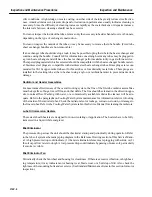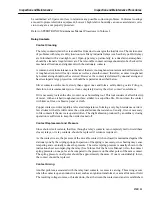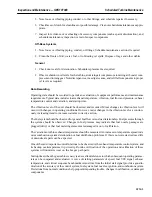
Inspection and Maintenance
Inspection and Maintenance Procedures
IMP–17
Two separate tests are necessary to ensure that the low-pressure CO
2
system is ready for operation. These
are (1) the electric release test and (2) the “puff” test.
Electric Release Test
Check the wiring in the circuit by short-circuiting each fire detector in turn. Each time this is done,
solenoid valve 45CR should energize. Before performing the Electric Release test, the system must
be disabled by means of the isolation valve in the control cabinet.
“Puff” Test
The “puff” test consists of discharging a small amount of CO
2
into the system as a final check on
the operation of the release mechanism and to be sure that all pressure-operated latches and ventila-
tion dampers operate properly. Conduct the test as follows:
1. Inspect the ventilation dampers in the accessory and turbine compartments and latch them in the
open position with the CO
2
-operated latches.
2. Check to see that solenoid valve 45CR is deenergized.
3. Clear all personnel out of the accessory and turbine compartments. Make sure all ventilating fans
are on during and after testing to remove the discharged CO
2
from the area.
4. Cycle each pneumatic timer by operating a push button station or by operating the manual release
to determine that the timing is as required. Cycling should be done with the discharge manifold
under pressure, but with the tank shutoff valve closed so as to provide only a “puff” discharge
vapor.
5. Cycling of the timers will also serve to prove operation of the pressure switches and in turn the
performance of electrical shutdown and annunciation.
Note:
The timing cycle can be aborted by closing the isolation valve and re-
setting the pressure switch after the timer re-sets.
6. When the system starts to discharge, relay 45FTX should pick up to trip the turbine. The fire
alarm bell in the accessory compartment should also ring, and the fire flag on the annunciator
should drop.
7. After CO
2
discharge has stopped, re-set pressure switch 45CP. When the compartments are clear
of CO
2
, also inspect to see that all ventilation dampers have operated properly.
At the completion of testing, refill the storage unit to capacity, as required. Bubble test the packing glands
of the tank shutoff valve and vapor supply valve for bubble tightness. Leave both locked in the full-open
position. The system is now ready for operation.
Summary of Contents for MS6001B
Page 2: ...Gas Turbine Inspection and Maintenance GEK 107048 I 2 THIS PAGE INTENTIONALLY LEFT BLANK ...
Page 4: ...Inspection and Maintenance Note THIS PAGE INTENTIONALLY LEFT BLANK ...
Page 13: ...INSERT TAB INTRODUCTION ...
Page 14: ......
Page 25: ...INSERT TAB STANDARD PRACTICES ...
Page 26: ......
Page 87: ...INSERT TAB AUXILIARY CONTROLS SYSTEMS MAINTENANCE ...
Page 88: ......
Page 133: ...INSERT TAB SCHEDULED TURBINE MAINTENACE ...
Page 134: ......
Page 157: ...INSERT TAB COMBUSTION INSPECTION ...
Page 158: ......
Page 239: ...INSERT TAB HOT GAS PATH INSPECTION ...
Page 240: ......
Page 313: ...INSERT TAB MAJOR INSPECTION ...
Page 314: ......
Page 316: ...Inspection and Maintenance GEK 107048 Major Inspection 2 THIS PAGE INTENTIONALLY LEFT BLANK ...
Page 363: ...INSERT TAB MAINTENANCE FORMS ...
Page 364: ......



